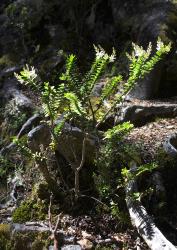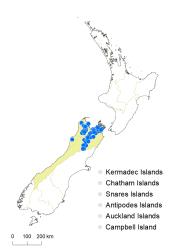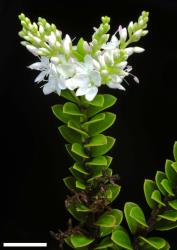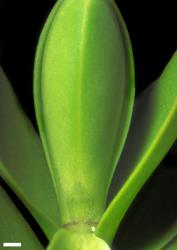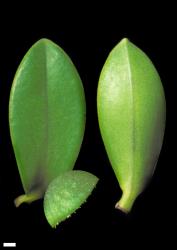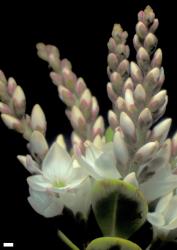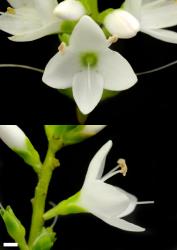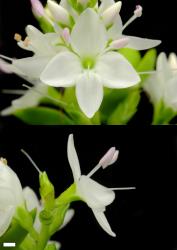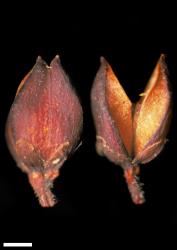- ≡ Hebe vernicosa (Hook.f.) Cockayne & Allan, Trans. New Zealand Inst. 57: 30 (1926)
- = Veronica greyi J.B.Armstr., N.Z. Ctry. J. 3: 57 (1879) – as grayi
- ≡ Hebe greyi (J.B.Armstr.) Cockayne, Trans. New Zealand Inst. 60: 471 (1929)
- = Veronica vernicosa var. gracilis Cheeseman, Man. New Zealand Fl. 520 (1906)
- = Veronica vernicosa var. multiflora Cheeseman, Man. New Zealand Fl. 520 (1906)
Spreading, low shrub to 0.8 m tall, rarely to 1 m. Stems spreading to obliquely ascending, eglandular-pubescent, hairs bifarious to uniform. Leaf bud distinct, its leaves appressed at margins until fully grown; sinus rhomboid to narrowly rhomboid. Leaves sub-distichous, erecto-patent to spreading; lamina sub-coriaceous, elliptic to obovate, 5–20 mm long, 2.5–8.0 mm wide, glossy, especially above, green to dark green above, green beneath, midrib evident; surfaces usually with eglandular hairs along midrib above, sometimes glabrous; margin glabrous or ciliolate, entire; apex sub-acute to obtuse, broadly and bluntly plicate-acuminate; base shouldered or abruptly narrowed to petiole; petiole 0.5–3.0 mm long. Inflorescence a lateral raceme, 16–72 mm long; flowers crowded, 9–43, all bisexual; bracts alternate, ovate to deltoid, ≥ pedicels; pedicels erecto-patent, 0–3.5 mm long, eglandular-pubescent all around. Calyx lobes 4, usually obtuse or rounded, rarely sub-acute or acute, 1.0–1.5 mm long, equal or sub-equal, usually mixed eglandular- and glandular-ciliolate, sometimes eglandular-ciliate. Corolla 6.0–8.5 mm diameter; tube white, 0.6–1.5 mm long, glabrous inside; lobes 4, white, sometimes pink when young, erecto-patent to spreading, unequal, elliptic to ovate, 3.5–5.0 mm long, sub-acute; nectar guides absent. Stamen filaments white, 3.0–5.5 mm long; anthers white to pale pink. Style glabrous, 2.7–7.0 mm long. Capsules latiseptate, sub-acute to obtuse, glabrous, 2.8–4.2 mm long, 1.6–2.5 mm at widest point. Seeds ellipsoid, obovoid, or oblong, flattened, smooth, pale brown, 1.3–1.5 mm long.
Veronica vernicosa is one of only a few hebes that are mostly found in montane southern beech forest. The species is easily recognised. It is characterised by spreading to obliquely ascending branches and shiny, quite small leaves arranged sub-distichously. The petioles are puberulent above and along the edges, but glabrous on the backs. The inflorescence is quite conical when the lowest flowers open, and flower development is strongly acropetal. The calyx lobes are short and almost always rounded to obtuse, and the corolla lobes taper to a sub-acute apex. The anthers are pink, often pale.
V. canterburiensis plants are similar, but they can be distinguished by often – although not always – having dense, short hairs on the backs of the petioles, markedly ciliolate leaf margins especially on the youngest leaves, longer calyx lobes (c. 2.0–3.1 mm long), corolla tube at least = calyx, often longer, corolla lobes usually more rounded, dark purple or magenta anthers, and a capsule that is no more than twice as long as the calyx. V. canterburiensis overlaps in distribution and also extends further south into Canterbury; it may also be found in montane southern beech forest, but extends above the tree line into sub-alpine grassland as well.
V. societatis plants have a similar growth form, but glaucous leaves, longer calyx lobes (1.5–2.0 mm long), a longer corolla tube ≥ calyx, magenta to purple anthers, and larger capsules (3.7–5.0 mm long). They grow in grassland above the tree line only on Mt Murchison, Braeburn Range.
The glossy green leaves are similar to those of V. odora. V. odora plants can be distinguished by their terminal inflorescences with large, opposite bracts and sessile flowers, and long corolla tubes and narrow corolla lobes, and their leaf bud sinus is broader and shield-shaped due to the abrupt narrowing of the lamina to the petiole.
South Island: Western Nelson (widespread from Gouland Downs south to Matiri Range), Sounds Nelson, Westland (Nelson Lakes National Park only); Marlborough (western Wairau Mountains, St James Range).
Southern beech forest, often at or near the tree line. Recorded elevations range from 606 to 1524 m.
Flowers: October–January; fruits: December–May, persisting to September.
2n = 42 (see Bayly & Kellow 2006, as Hebe vernicosa).
Veronica vernicosa is classified in V. subg. Pseudoveronica sect. Hebe and the informal group “Apertae” (small-leaved) (Albach & Meudt 2010; Bayly & Kellow 2006). The relationships of V. vernicosa are puzzling. Although it looks very similar to V. canterburiensis, its chromosome number and its ITS sequence data both indicate it diverged at a node low in the tree of shrubby hebes, close to the whipcord hebes.



